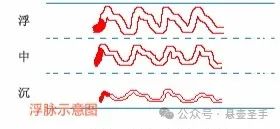
Floating pulse (fú mài) is one of the most representative types in Traditional Chinese Medicine (TCM) pulse diagnosis. By exploring its body image, main diseases, and associated pulses, we can better understand the intrinsic connection between diseases and pulse manifestations.

“Floating on the skin like wood on water; abundant when lifted, insufficient when pressed,” this verse vividly describes the characteristics of the floating pulse. The floating pulse can be easily felt with light pressure, similar to wood floating on the water’s surface, where the pulse is distinctly noticeable with a gentle touch, indicating “abundant when lifted”; however, when slightly more pressure is applied, the pulse sensation diminishes, which is “insufficient when pressed.” This characteristic reflects that the pulse is located relatively shallow, primarily manifesting at the skin’s surface.
In TCM theory, the floating pulse belongs to the yang pulse category, typically indicating that the disease is located at the surface. Specifically, the appearance of a floating pulse at different locations corresponds to different main symptoms.
Floating pulse at the cun position: The cun position corresponds to the upper part of the body, and a floating pulse here often suggests symptoms of wind-cold, with patients commonly experiencing headaches and nasal congestion. This is because the wind pathogen invades the body’s surface, primarily affecting the upper meridians and orifices, leading to obstructed qi and blood flow, resulting in these symptoms.
Floating pulse at the left guan position: The left guan corresponds to the liver and spleen in the middle jiao. A floating pulse at this position indicates that the wind pathogen has invaded the middle jiao. The middle jiao is crucial for the transformation and transportation of the spleen and stomach, and the invasion of wind can disrupt the normal functions of the spleen and stomach, as well as the smooth flow of liver qi, causing a series of discomfort symptoms in the middle jiao.
Floating pulse at the right guan position: The right guan also belongs to the middle jiao category, and a floating pulse here suggests that wind-phlegm is accumulating in the diaphragm. The diaphragm is located between the chest and abdominal cavities, and the obstruction of wind-phlegm here can affect the rising and descending of qi, leading to symptoms such as chest tightness and phlegm cough.
Floating pulse at the chi position: The chi position corresponds to the lower jiao, and a floating pulse indicates that the lower jiao is being invaded by wind. The retention of wind in the lower jiao can affect the bladder’s qi transformation function, leading to difficulties in urination; it may also impact the intestines’ conduction function, causing constipation.
The floating pulse often appears alongside other pulse types, forming associated pulses. Different combinations of associated pulses indicate different diseases.
Weak indicates exterior deficiency, strong indicates exterior excess: This is the main diagnostic judgment when the floating pulse is either strong or weak. A weak floating pulse often indicates exterior deficiency, suggesting that the body’s righteous qi is relatively insufficient; although there is an invasion of external pathogens, the body’s resistance is weak; a strong floating pulse indicates exterior excess, meaning the body’s righteous qi is sufficient to vigorously combat external pathogens.
Floating and tight pulse indicates wind-cold: The simultaneous presence of a floating pulse and a tight pulse suggests an invasion of wind-cold at the muscle surface. The tight pulse is like a taut rope, tense and strong, combined with the floating pulse, indicating that cold pathogens are constraining the exterior, obstructing the defensive qi, with patients often experiencing chills, fever, and absence of sweating.
Floating and slow pulse indicates stroke: A floating pulse combined with a slow pulse is often seen in stroke cases. The slow pulse indicates cold; here, the slowness is not merely a cold manifestation but reflects a relative sluggishness in the movement of qi and blood due to the invasion of wind, indicating that the wind pathogen is accompanied by cold, or that the body’s yang qi has been impaired by the wind.
Floating and rapid pulse indicates wind-heat: The simultaneous presence of a floating pulse and a rapid pulse suggests an invasion of wind-heat at the body surface. The rapid pulse indicates heat; the invasion of wind-heat accelerates the movement of qi and blood, resulting in a floating and rapid pulse, with patients often experiencing fever and sore throat as symptoms of wind-heat.
Floating and relaxed pulse indicates wind-damp: A floating and relaxed pulse is often seen in wind-damp conditions. The relaxed pulse suggests sluggishness, and a floating relaxed pulse indicates that wind-damp has invaded the muscle surface, with dampness obstructing the movement of qi and blood, leading to symptoms such as heaviness and soreness in the limbs.
Floating and hollow pulse indicates blood loss: A hollow pulse feels empty, like pressing on a scallion tube, and a floating hollow pulse suggests a condition of blood loss. After blood loss, the blood volume in the vessels decreases, failing to adequately fill the pulse channels, hence the pulse is felt with light pressure but becomes hollow with heavier pressure, reflecting a state of yin and blood deficiency.
Floating and short pulse indicates qi deficiency: A floating short pulse indicates a qi disorder. The floating short pulse suggests that the body’s qi is not flowing smoothly, insufficient to fill the pulse channels, often seen in qi deficiency or qi stagnation conditions, with patients possibly experiencing shortness of breath and fatigue.
Floating and surging pulse indicates empty heat: A surging pulse resembles turbulent waves, and a floating surging pulse is often seen in conditions of empty heat. The internal generation of empty heat causes qi and blood to surge, presenting a floating surging pulse; however, this surging pulse is not as strong and persistent as a solid heat pulse, reflecting a state of empty heat with yin deficiency and yang excess.
Floating and weak pulse indicates heat exhaustion: A floating weak pulse is often seen in states of exhaustion after heatstroke. The heat pathogen depletes the body’s qi and yin, leading to a floating and soft pulse, with patients commonly experiencing body heat, thirst, and fatigue as symptoms of heatstroke.
Floating and choppy pulse indicates blood injury: A choppy pulse is difficult to feel, and a floating choppy pulse suggests blood injury. This is often due to internal blood stasis or yin blood deficiency, leading to obstructed movement of qi and blood, resulting in a pulse that is floating and choppy.
Floating and soft pulse indicates qi failure: A soft pulse is floating, thin, and weak, and a floating soft pulse suggests a decline in the body’s righteous qi. Qi is the driving force of life activities; when the righteous qi declines, qi and blood production is insufficient, leading to a floating soft pulse, often seen in individuals with chronic illness or significant depletion of vital energy.
The floating pulse, through its unique body image, main disease patterns, and rich variations of associated pulses, provides important clues for TCM diagnosis, helping practitioners accurately assess conditions and formulate appropriate treatment plans.




